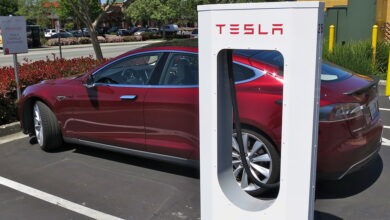Tesla’s Shares Drop by Almost 10% Following Year-On-Year Earnings Decrease

Tesla reported a decline in net income and earnings per share (EPS) compared to the year-ago quarter, leading to a nearly 10% drop in its shares. The company’s strategy of prioritizing higher volumes over higher margins resulted in concerns from analysts, with Wells Fargo warning of longer-term damage to Tesla’s brand. Tesla has cut US prices six times since January, with Oppenheimer stating that near-term margin pressure would continue to be a concern for investors. However, Tesla’s shares remain up by almost 47% year to date.
Shares of the electric vehicle manufacturer, Tesla, fell by almost 10% on Thursday, a day after the company reported a more than 20% drop in net income and earnings per share (EPS) compared with the year-ago quarter.

For the first quarter of 2023, Tesla reported net income of $2.51 billion, down 24% from the prior year, and GAAP earnings per share of 73 cents, down 23% from the year before. Tesla CEO, Elon Musk, also suggested that the company would prefer higher volumes to higher margins, a comment that prompted some concern from analysts.
“We’ve taken a view that pushing for higher volumes and a larger fleet is the right choice here, versus a lower volume and higher margin,” Musk said on an earnings call. Tesla has cut U.S. prices six times since January, with the most recent reduction this Tuesday. Tesla has cut the price of its Model 3 by 11% this year. Prices of its Model Y have been lowered by 20%.
“We are cautious of the discounting given LT brand risk,” a note Thursday from Wells Fargo read, referring to longer-term damage to Tesla’s brand. Wells Fargo cut its price target for the company from $190 to $170.
Analysts from Oppenheimer wrote that while Tesla would benefit over time from the potential market share gains that price cuts could bring, “near-term margin pressure” would continue “to be a concern for investors.” Oppenheimer has a performance rating on Tesla’s stock.
Tesla shares remain elevated from a dismal 2022 performance which mirrored the broader downturn in tech companies. Shares of the electric vehicle manufacturer are up nearly 47% year to date as of Wednesday’s close.
In this article, we will take a closer look at Tesla’s first-quarter earnings report, analyze the factors that led to the decline in net income and EPS, and discuss the implications of the company’s strategy of prioritizing higher volumes over higher margins. We will also examine the impact of Tesla’s price cuts on its brand image and market share, and evaluate the reactions of analysts and investors to the earnings report.
Tesla’s First-Quarter Earnings Report
Tesla’s first-quarter earnings report showed a decline in net income and EPS compared to the year-ago quarter. The company reported a net income of $2.51 billion, down 24% from the prior year, and GAAP earnings per share of 73 cents, down 23% from the year before. While the company’s revenue increased by 37% to $15.39 billion, its gross margin decreased from 24.7% to 22.5%.
Tesla’s automotive revenue increased by 34% to $12.6 billion, but its energy generation and storage revenue increased by only 1% to $754 million. The company’s automotive gross margin decreased from 26.5% to 24.1%, while its energy generation and storage gross margin increased from 8.8% to 12.1%.
The company delivered 261,000 vehicles in the first quarter, an increase of 2% compared to the year-ago quarter, but a decrease of 3% compared to the fourth quarter of 2022. Tesla’s vehicle production was also impacted by supply chain issues and the global semiconductor shortage, which forced the company to temporarily suspend production at some of its factories.




